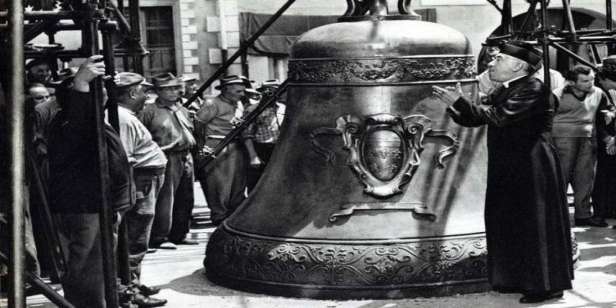
A cinematographic saga, that ofDon Camillo and Peppone, which continues to be loved, thanks to the constant re-proposals of the television networks. It happens, in fact, that some television network re-proposes the quarrel between the priest of Brescello and the communist Peppone whoGiovannino Guareschihe invented giving birth to numerous novels that have been widely read. To whose cinematographic characters they gave life above all, as is known,FernandeleGino Cervi. Which were theprotagonists of 5 chapters.
A Saga, the one told by Guareschi, which fully reflectsthe political and social climate of the Italian province of that period. The first is, therefore,Don Camillo, from 1952 directed byJulien Duvivier, and tells of the robust and combative parish priest ofBrescello, a small town in the Lower Po Valley, which is perpetually at odds with the Communist Mayor Peppone: two protagonists of the life of the town who, however, after sometimes violent clashes, end up coming to an agreement, letting themselves be guided by common sense. In this first film, we see them in nice dispute: Peppone, after the victory in the elections, wants to build a magnificent Casa del Popolo and Don Camillo, not wanting to be outdone, works hard to complete the construction of his oratory. With a fiery temperament, and we will also see him in the other films, which often leads the Crucifix in his little church to reproach him.

The second isThe return of Don Camillo(1953), also directed byDuvivier, where we see Don Camillo, who in the previous film had left Brescello, in the half-ruined church of a remote mountain town. In that place he will feel very alone and think with nostalgia of the Crucifix of the high altar in his former parish, from which he received salutary warnings. He will return there because the ancient parishioners miss the pugnacious parish priest, and also the Mayor Peppone who wants him to be an ally in a fight against a landowner. For this, he will turn to the Bishop to make him return. But as soon as he returned, the friction between the parish priest and the communists, headed by Peppone, was renewed. But when the Po overwhelms the banks and threatens the town, Don Camillo and Peppone compete in their efforts and do their utmost for the good of the country. The third episode isDon Camillo and the Honorable Peppone(1955), directed byCarmine Gallonewho takes over from Duvivier. The film continues to tell the antagonism between Don Camillo and Peppone which becomes more violent during the electoral period, since the Communist mayor was included in the popular front list. To give him support, the Federation sends Brescello an energetic companion, yes, but not devoid of personal attractions, to which Peppone does not show himself insensitive. A love affair that could harm Peppone's domestic tranquility if Don Camillo did not intervene promptly to restore peace to the family. Again by Carmine Gallone the fourth episode of the Saga. It is entitledDon Camillo Monsignore… but not too muchand sees the two colorful characters of Brescello who have made a career: the parish priest Don Camillo has become a monsignor and the mayor Peppone has been elected to the Senate. Both are in Rome, and despite never seeing each other, they are unconsciously united by nostalgia for their country.

The miracle unexpectedly comes true: in Brescello a big quarrel breaks out between Communists and Catholics and the PCI on the one hand and the Vatican on the other find nothing better than to send Peppone and Don Camillo on the spot, as moderators, so that an agreement can be reached about the construction of the Casa del Popolo whose construction would require the demolition of a small votive chapel. Objective that they reach after, as was to be expected, numerous bickering. Eventually the two return to Rome shaking hands. Change of direction again in the fifth episode, which passes toLuigi Comencini. Things went like this: Comencinihe directed it to pay off a debt. The company he was a partner in had gone bankruptMorino Film, and he found himself with an enormous debt to Rizzoli which he then ordered him to pay himComrade Don Camillo, with an attendance fee as pay. The funny thing is that after Comencini had signed one of the partners of Morino Film telephoned him at home informing him that the thieves had robbed Rizzoli's studio, stealing all the bills. But by now he had agreed to direct the film. The story tells that in Brescello, where the two had returned, a twinning with a country in the Russian countryside is being organized. The pugnacious parish priest does not like the initiative and thinks of opposing it by using for propaganda purposes a couple of Russian refugees who host from farmhouse to farmhouse. But the expedient loses all value when it turns out that they are two very Italian swindlers. The twinning is decided, Don Camillo, threatening Peppone to make a sentimental escapade public, manages to get himself included in the list of starters under a fictitious name. He will obviously be the most restless guest, not forgetting his priestly mission in every situation. And Peppone will take his revenge by making himself admitted, dressed as a monsignor, on a cruise of young priests that Don Camillo, returning to Brescello, will have the task of accompanying to the United States. The fifth episode concludes the series starring Fernandel and Gino Cervi, which, after all, is the one most loved by the spectators.